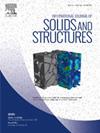Estimation of energy dissipation during dynamic shear band evolution
IF 3.4
3区 工程技术
Q1 MECHANICS
International Journal of Solids and Structures
Pub Date : 2024-12-22
DOI:10.1016/j.ijsolstr.2024.113202
引用次数: 0
Abstract
The adiabatic shear band (ASB) criterion is crucial for assessing the shear failure resistance of metals and alloys under dynamic loading. While the critical shear strain obtained from macroscopic stress–strain curves has been widely employed to predict ASB nucleation, it cannot describe the subsequent ASB evolution process, which occurs at extreme spatial (∼µm) and temporal (∼µs) scales. In this work, we introduce a generalized shear band toughness to characterize the post-localization energy dissipation within the band, which can be estimated from temperature fields captured by high-speed, high-resolution infrared thermal detectors. The generalized shear band toughness model accounts for contributions from both thermal softening and microstructure-related softening mechanisms in ASB evolution. We systematically characterize the shear band toughness across a range of materials, from conventional alloys to advanced high-entropy alloys. Finally, the shear band toughness is incorporated into a dual-stage, energy-based shear banding criterion, which proves crucial for accurately predicting the entire shear banding process, particularly in scenarios involving dynamic shear band propagation in large structures.
求助全文
约1分钟内获得全文
求助全文
来源期刊
CiteScore
6.70
自引率
8.30%
发文量
405
审稿时长
70 days
期刊介绍:
The International Journal of Solids and Structures has as its objective the publication and dissemination of original research in Mechanics of Solids and Structures as a field of Applied Science and Engineering. It fosters thus the exchange of ideas among workers in different parts of the world and also among workers who emphasize different aspects of the foundations and applications of the field.
Standing as it does at the cross-roads of Materials Science, Life Sciences, Mathematics, Physics and Engineering Design, the Mechanics of Solids and Structures is experiencing considerable growth as a result of recent technological advances. The Journal, by providing an international medium of communication, is encouraging this growth and is encompassing all aspects of the field from the more classical problems of structural analysis to mechanics of solids continually interacting with other media and including fracture, flow, wave propagation, heat transfer, thermal effects in solids, optimum design methods, model analysis, structural topology and numerical techniques. Interest extends to both inorganic and organic solids and structures.

 求助内容:
求助内容: 应助结果提醒方式:
应助结果提醒方式:


